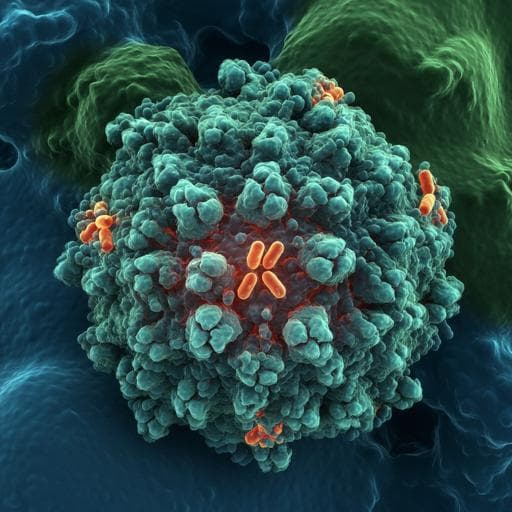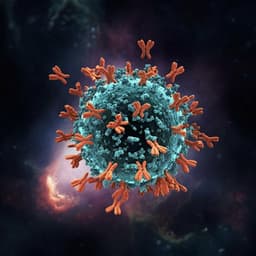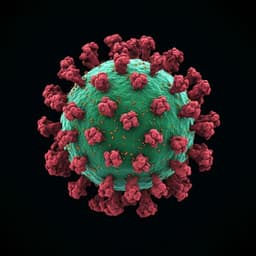
Medicine and Health
Structural insights into the broad protection against H1 influenza viruses by a computationally optimized hemagglutinin vaccine
J. V. Dzimianski, J. Han, et al.
Influenza virus continues to threaten global health with its pandemic potential. This groundbreaking research by John V. Dzimianski and colleagues explores the COBRA hemagglutinin proteins, uncovering their broad immunogenicity through crystal and cryo-EM structures. Discover the unexpected mechanisms behind an atypical receptor binding site epitope that could revolutionize vaccine strategies against influenza!
~3 min • Beginner • English
Introduction
Seasonal and pandemic influenza continue to pose a major global health burden, with vaccine effectiveness varying widely due to antigenic drift and the diversity of circulating strains. To achieve broader and more durable protection, computationally optimized broadly reactive antigens (COBRAs) have been developed using iterative consensus design across historical and contemporary hemagglutinin (HA) sequence datasets. COBRA HAs, including the H1 candidate P1, have shown broad protection in preclinical models, but the structural mechanisms underlying this breadth and the epitopes targeted by elicited broadly neutralizing antibodies remain unclear. This study aims to elucidate the structural basis of P1’s broad immunogenicity by determining the high-resolution structure of the COBRA P1 HA and the structure of a P1-elicited broadly neutralizing antibody (1F8) in complex with P1, to define antigenic features, glycosylation effects, and epitope-paratope interactions that drive breadth.
Literature Review
Prior work has demonstrated that COBRA-designed HAs can elicit broader protection than wildtype HAs in animal models against both historical and emerging influenza strains. Distinct from approaches that predefine antigenic targets (e.g., stem-focused immunogens, headless HA, chimeric HA, and hyperglycosylation to redirect responses), COBRA uses sequence-based consensus design to capture both conserved and divergent features across a design space. RBS-targeting antibodies have been prioritized as broadly reactive therapeutics, with known binding motifs often involving heavy-chain CDR loops engaging conserved RBS residues. Glycosylation patterns on the HA head modulate antigenicity and can steer immune responses; specific head glycans (e.g., at Asn125/Asn127) have been implicated in immune evasion and breadth. Despite these insights, detailed structural understanding of COBRA HAs and the epitopes of COBRA-elicited bnAbs has been limited.
Methodology
- Antigen design and expression: The COBRA P1 HA ectodomain was expressed via baculovirus in Sf9 insect cells with a gp67 signal peptide, T4 foldon trimerization domain, thrombin site, His and Strep tags. After affinity purification, the foldon and tags were removed by thrombin cleavage, and trimeric P1 was isolated by size-exclusion chromatography.
- X-ray crystallography: Trimeric P1 was crystallized (optimized condition: 0.25 M MgCl2, 0.1 M Tris pH 8.5, 15% PEG 4000, 6% PEG 400). Data were collected at APS 23ID-D and processed with DIALS/AIMLESS. Molecular replacement used a computational HA model (PHENIX Phaser). Model building/refinement used COOT/PHENIX with validation by Privateer/MolProbity. Final resolution: 3.0 Å; space group C21; PDB deposition reported.
- Mutagenesis and mammalian expression: An N127D P1 mutant was generated by site-directed mutagenesis. Wildtype P1 and P1 N127D were expressed in CHO cells and purified via HisTrap and SEC for binding assays.
- Antibodies: Mouse mAbs CA09-11 and CA09-15 were purified from ascites; CA09-15 Fab was generated enzymatically. The 1F8 Fab variable domains were cloned into expression vectors, produced in CHO cells, affinity purified (StrepTrap), tag-cleaved, and polished by SEC.
- Biolayer interferometry (BLI): Binding kinetics were measured on an Octet RED384 in PBS/1% BSA/0.05% Tween 20 at 30°C. His-tagged HAs were loaded on anti-Penta-His biosensors; association/dissociation with antibodies or Fabs were recorded across dilution series. Models (1:1, 1:2, or 2:1) were selected based on fit metrics; averages from two independent experiments reported.
- Cryo-EM: P1 was complexed with 1F8 Fab (and an additional anchor Fab P1-05 that was masked out during processing) and vitrified on Quantifoil grids. Data were acquired on a Titan Krios with a K2 detector (300 kV, pixel 1.045 Å, total dose ~50 e−/Å2). Particles were processed in cryoSPARC (2D classification, heterogeneous and non-uniform refinements, CTF refinements) in C1 symmetry. Final map resolution: 3.1 Å (FSC 0.143). The P1 crystal structure and a modeled 1F8 Fv were fit and refined in COOT/PHENIX; validation by MolProbity and EMRinger. EMDB/PDB entries provided.
Key Findings
- COBRA P1 structure and integrity: The 3.0 Å crystal structure of P1 shows a native-like prefusion HA0 trimer with classical head and stem architecture, proper display of antigenic sites, and glycosylation at predicted motifs, confirming structural integrity of the computationally designed antigen.
- Antigenic site concordance explains breadth: Structural comparison of P1 to HA from A/California/04/2009 (CA/04/09) and A/Solomon Islands/3/2006 (SI/3/06) shows close similarity at head antigenic sites Sa and Sb for CA/04/09 but substantial differences for SI/3/06, rationalizing P1’s strong protection against pandemic-related strains and weaker protection against some pre-2009 seasonal strains. Central stem and anchor epitopes are conserved across P1 and both strains.
- Atypical glycosylation at Asn127 modulates head-site accessibility: P1 contains a rare glycosylation at Asn127 near the Sa region. This glycan reduces binding of the CA09-15 head-targeting antibody. BLI kinetics showed CA09-15 IgG binds P1 wt with KD ~112.3 nM versus P1 N127D with KD ~4.38 nM; for CA09-15 Fab, P1 N127D showed KD ~26.95 nM, whereas binding to P1 wt was markedly weaker. Thus, Asn127 glycosylation can shield Sa-proximal epitopes.
- Broadly neutralizing mAb 1F8 targets the RBS with a unique orientation: Cryo-EM at 3.1 Å of P1 bound to 1F8 reveals two Fabs per trimer engaging a conformational epitope (~700 Å2). The epitope comprises the receptor binding site (RBS) and part of Ca2. Unusually, the light-chain CDRL1 inserts into the RBS; Phe30a packs with HA Trp150, and Asp30b contacts Tyr91, while the heavy chain primarily contacts Ca2 (including a Glu50–Lys141 salt bridge in P1). This light-chain–driven RBS engagement contrasts with canonical RBS antibodies that use heavy-chain CDRs and approach at a steeper angle.
- 1F8 affinity and glycan proximity: BLI showed high-affinity binding of 1F8 Fab to P1 wt (KD ~2.95 nM) and slightly tighter to P1 N127D (KD ~0.86 nM), indicating Asn127 glycan does not directly mediate 1F8 binding but may modestly impact accessibility.
- Strain-specific compatibility at Ca2 explains differential breadth: In CA/04/09, the Lys corresponding to P1 Lys141 is shifted to Ser142, eliminating the optimal salt bridge with 1F8 Glu50, reducing affinity relative to P1; in SI/3/06, Glu at 141 introduces charge repulsion, further diminishing activity. These structural differences align with previously observed neutralization patterns.
- Comparative analysis suggests a new class of RBS antibodies: 1F8 shares a common dipeptide motif (hydrophobic residue–Asp) seen in several RBS antibodies, but uniquely deploys light-chain CDRL1 for RBS engagement, allowing heavy-chain interactions with Ca2. A recently reported mouse antibody (12H5) exhibits a similar mode with different heavy-chain usage, supporting a class of light-chain–engaging RBS antibodies.
Discussion
The study addresses how a COBRA-designed H1 HA (P1) elicits broad protection and the epitope targeted by a P1-elicited bnAb. Structural comparisons show that P1 maintains antigenic features aligning with pandemic-related strains, accounting for cross-protection, while differences with certain seasonal strains explain gaps. The rare Asn127 glycan, incorporated by consensus design, can shield variable head epitopes (e.g., Sa) to bias the response away from strain-specific sites without blocking access to conserved sites such as the RBS. The 1F8 structure reveals a distinct, light-chain–mediated RBS engagement that, combined with heavy-chain contacts in Ca2, provides a conserved anchor with tunable strain compatibility at Ca2. This dual engagement mechanism rationalizes both breadth and its limitations and suggests potential for optimizing heavy-chain interactions to broaden coverage across H1 lineages. More broadly, the findings underscore the potential of COBRA antigens to elicit polyclonal breadth and bnAbs comparable to heterologous immunization with multiple wildtype strains, and they highlight the value of integrating structural features (including glycosylation patterns) into rational vaccine design pipelines beyond sequence identity alone.
Conclusion
This work provides high-resolution structures of the COBRA H1 HA P1 and its complex with the broadly neutralizing antibody 1F8, defining antigenic and glycan features that contribute to broad protection. Key advances include: (1) validation of P1 as a native-like prefusion trimer; (2) identification of a rare Asn127 glycan that modulates head epitope accessibility and can promote broader polyclonal responses; and (3) discovery of a unique light-chain–driven RBS-targeting mode by 1F8 that, together with Ca2 contacts, explains breadth and points to a new antibody class. These insights inform structure-based vaccine design, suggesting deliberate inclusion or modulation of specific glycosylation sites and the optimization of epitopes that favor elicitation of RBS-targeting antibodies. Future work should test COBRA HA performance and the prevalence of 1F8-like responses in human cohorts, explore engineering of heavy-chain interactions to expand strain compatibility, and integrate structural constraints into next-generation COBRA design algorithms.
Limitations
Most efficacy data for COBRA HAs, including P1, derive from preclinical animal models. The translatability to humans with diverse genetic backgrounds and complex exposure histories remains to be fully established. Additionally, while structural analyses rationalize breadth and gaps, they do not capture all functional aspects of immune responses (e.g., polyclonal serum effects, T-cell responses), and certain features (e.g., flexibility of accessory Fabs in cryo-EM) were not resolved in detail.
Related Publications
Explore these studies to deepen your understanding of the subject.







